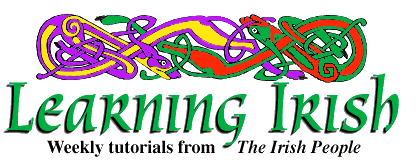
Irish Lesson 1
|
With this issue we begin the rerun of our study course in Irish. The purpose of the course is to give Americans, whether of Irish descent or not, a working knowledge of the Irish language. This course begins with the basics and is entirely self-contained. We have planned it especially for persons who are studying alone or in small groups without a teacher, books or recordings. To keep your past study lessons handy, each week remove the lesson from the paper and paste or staple it into a notebook, so that you will have the lessons available for review or reference. Pronunciation and study methods are important for you who are learning Irish in this way. We will say a few words about these two subjects first.
Pronunciation The pronunciation given in the guide for this lesson series is not based exclusively on any one region of Ireland. Where the differences are significant, we will give you some of the other pronunciations and usage, to make it easier to talk to all speakers.
Study Method
Most of the symbols are letters and letter groups for sounds common in familiar English words. If you pronounce them in that way for the first few lessons, you will be close enough for a beginning. We will gradually correct you and improve your pronunciation as you advance, so that you will soon have a genuine Irish pronunciation. For most consonants, such as b, d, f, g, h, l, m, n, p, r, s, and t we will use the letters themselves as pronunciation symbols. In the lessons you will get instructions on how to pronounce these sounds in the Irish way. Nearly all these consonants have two sounds in Irish, depending on what vowels are next to them. (English "c" and "g" also have this characteristic. Notice how you start to pronounce "king" and "coat", and then "give" and "go".) The vowel symbols may need some explanation, so here are the symbols and description of their pronunciation:
Symbols and pronunciation We will capitalize the letters in the accented part of the word or phrase. We will use asterisks, as in some symbols above, to indicate a sound fairly different from usual English sounds. Remember, too, that many Irish sounds are not exactly like their English counterparts. Some English sounds, such as "z" and "th" are not in Irish. Now try these English words as practice in using the pronunciation guide system: (boht) (HAM-muhr) (kin) (KUH-stuhm-ayr-ee) (de-LIV-uh-ree) (giv) (trans-LAYT) (ad-MEYE-uhr) (ful-FIL) (fuhn-duh-MENT-uhl) (wohnt) (wawnt) (tawt). The actual English words for these are: boat, hammer, kin, customary, delivery, give, translate, admire, fulfill, fundamental, won't, want, taught. These sounds are not always exact, as you can see, but are close enough to be understood. With these important preliminaries taken care of, you will make your entry into Irish next week. (c) 1997 The Irish People. May be reprinted with credit. |